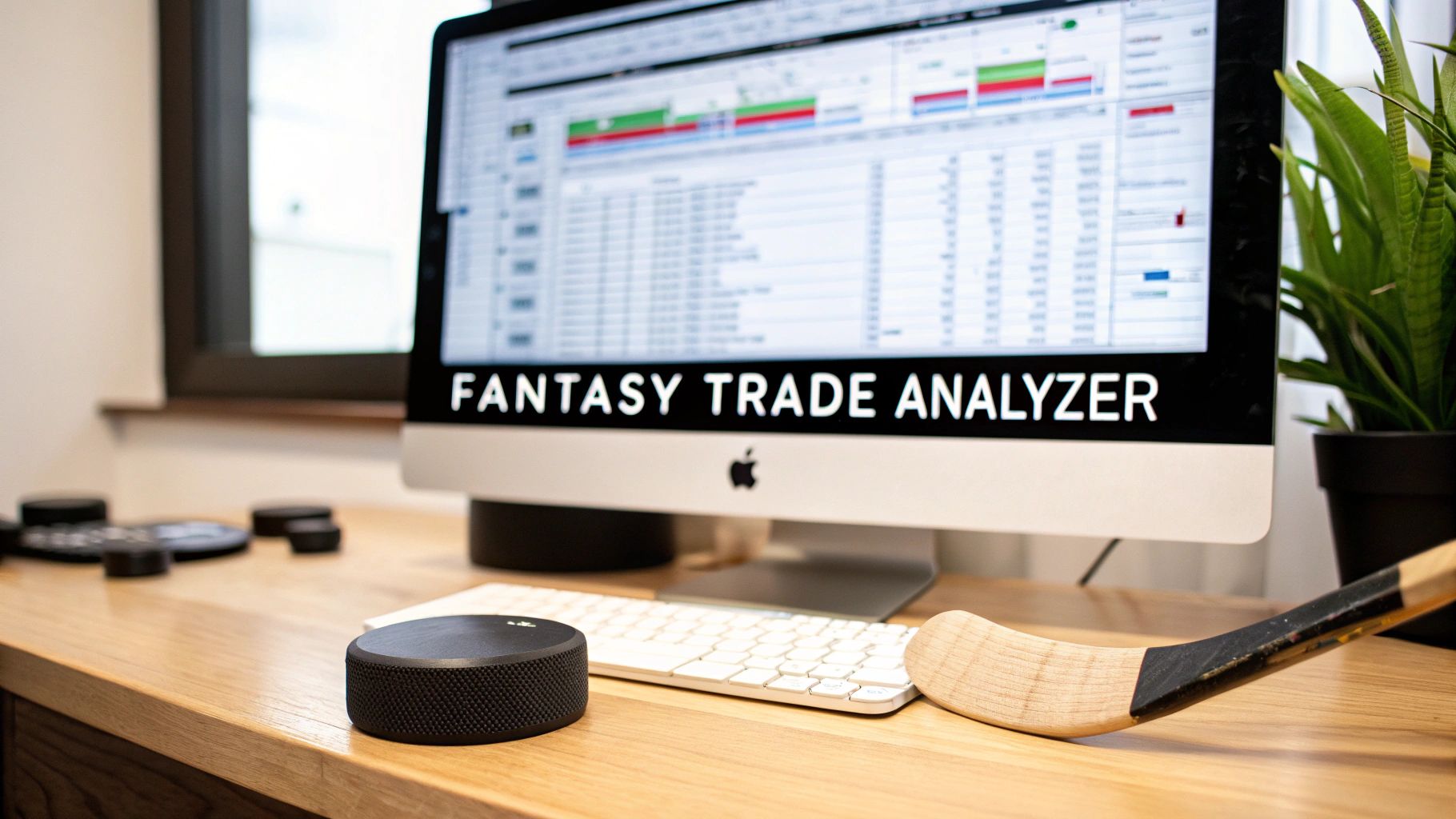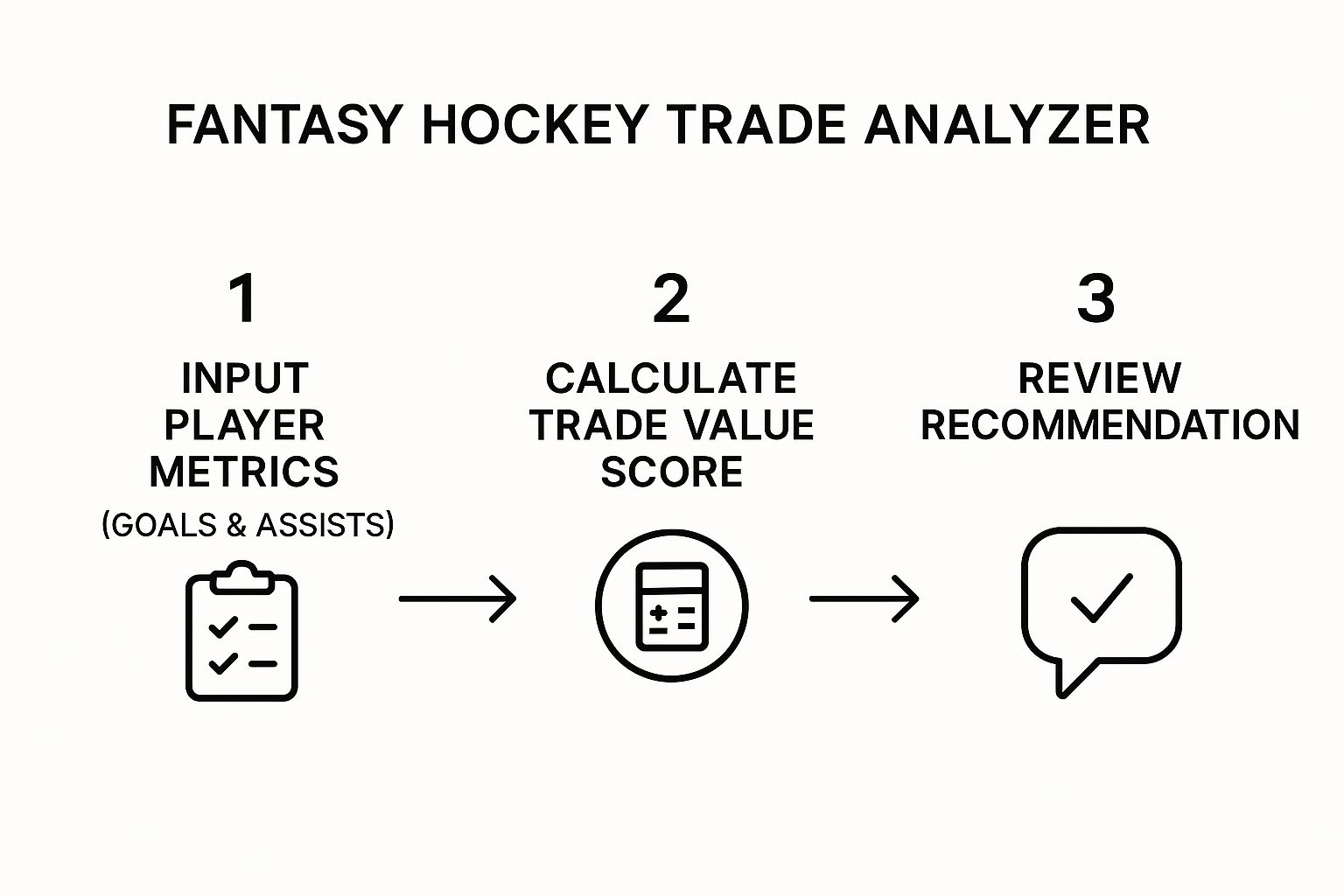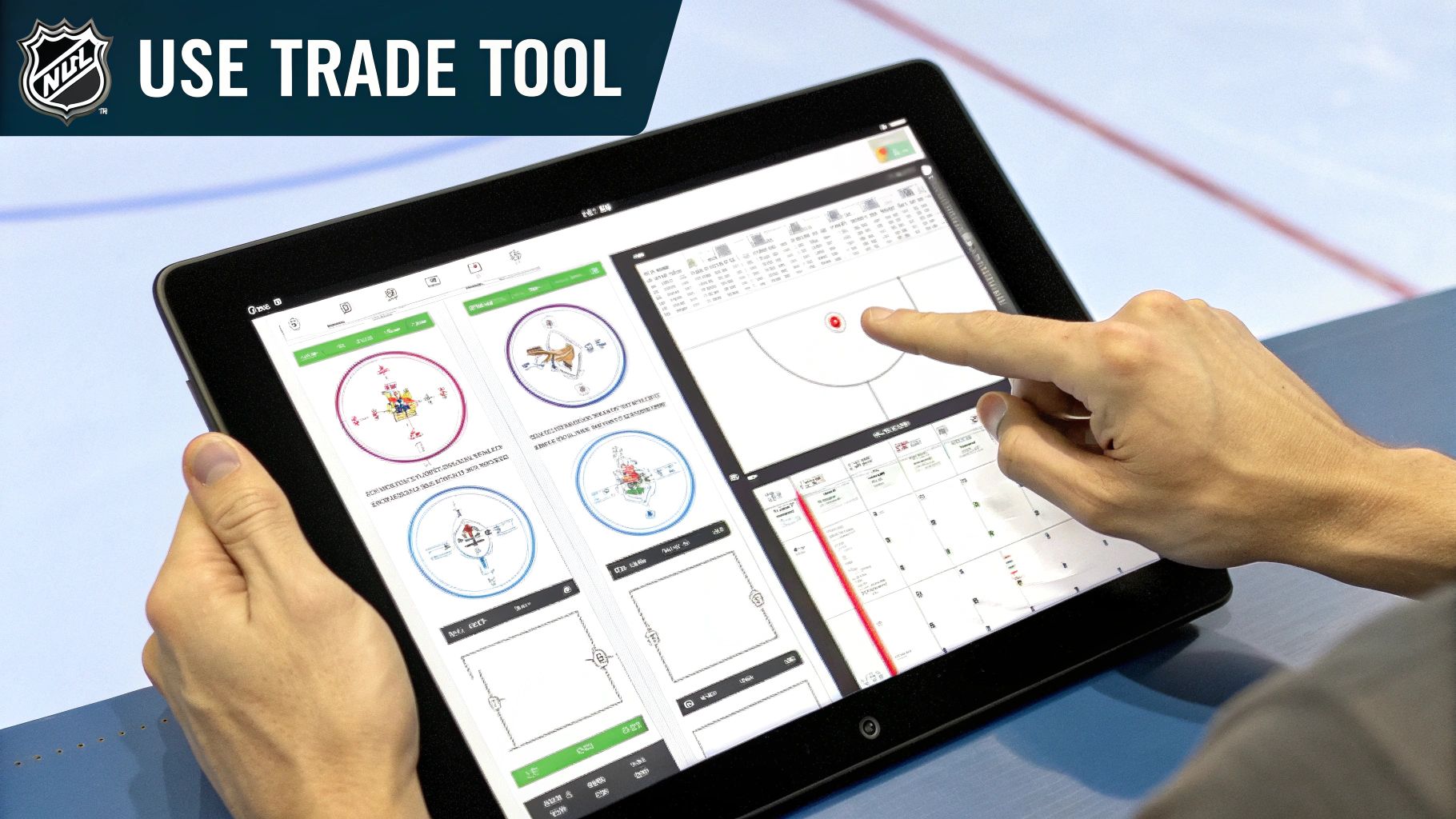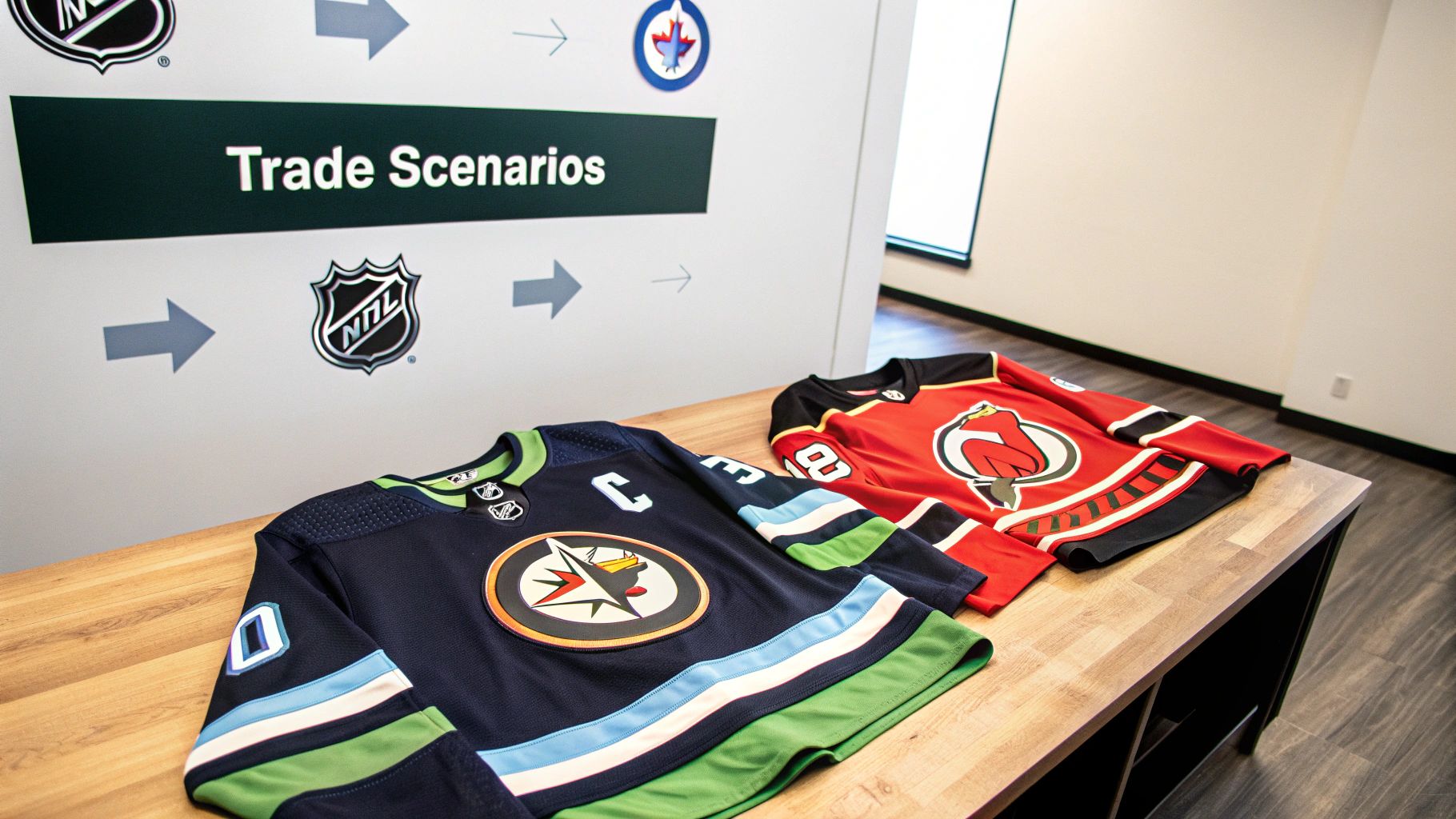Dominate Your League with a Fantasy Hockey Trade Analyzer

A fantasy hockey trade analyzer is your secret weapon for making smarter deals. It’s a tool that digs into your league’s specific scoring rules to figure out if a trade is truly balanced or lopsided. By crunching the numbers on dozens of stats, it gives you an objective, data-driven second opinion that goes way beyond gut feelings. This is how you build a championship-calibre team—by consistently winning your trades.
Winning Trades Start with the Right Data
We’ve all been there. Staring at the "propose trade" button, filled with that nagging hesitation. Am I giving up too much? Am I getting enough back? This is exactly where a fantasy hockey trade analyzer changes everything, swapping that uncertainty for calculated confidence. Think of it as your personal analytics department, breaking down complicated deals into simple, actionable advice.
At its heart, the tool assigns a numerical value to every player, but its real power lies in the details. A good analyzer goes far beyond just goals and assists; it soaks up all the unique quirks of your league to make sure its recommendations are perfectly tuned to how you score points.
- League-Specific Scoring: A guy like Brady Tkachuk is a solid forward in most standard leagues. But in "banger" leagues that count hits and penalty minutes, he transforms into an elite, league-winning monster. The analyzer knows this.
- Positional Needs: The tool helps you see the bigger picture. Are you creating a logjam at centre or plugging a massive hole on defence? Basic player rankings almost never account for this.
- Rest-of-Season Projections: It’s not about what a player has done, but what they’re going to do. The analyzer looks ahead, factoring in expected performance for the rest of the season.
Uncovering Hidden Value
One of the biggest advantages an analyzer gives you is the ability to spot market inefficiencies. It helps you pinpoint undervalued players on other teams who might be slumping but are projected to bounce back strong. On the flip side, it’ll wave a red flag when one of your own players is performing way over their head, creating the perfect sell-high opportunity to cash in.
For anyone in a competitive Canadian fantasy hockey league, these tools are practically essential. The ability to compare multiple players on both sides of a deal is critical for a deep dive into the numbers. You can find out more about how managers use these tools to gain an edge on rotoballer.com.
The best trades aren't always about getting the biggest name. They're about grabbing the most value for your team based on your league's settings.
Here’s a look at a pretty standard interface you'll see when using a fantasy hockey trade analyzer.

This screenshot gives you that clean, side-by-side comparison, making it dead simple to see which team is getting the better end of the deal based on the calculated values.
Essential Features in a Modern Trade Analyzer
Not all analyzers are created equal. To make sure you're getting strategic, accurate advice, look for a tool that includes these core functions. They separate the basic calculators from the true game-changers.
| Feature | What It Does | Why It's Critical |
|---|---|---|
| Custom League Sync | Imports your specific league's scoring categories, roster spots, and player pool. | Generic advice is useless. This ensures all valuations are tailored to what actually wins points in your league. |
| Multi-Player Trades | Allows you to analyze complex deals involving more than one player on each side. | Real-world trades are often 2-for-2 or 3-for-1. The tool must handle this complexity to be useful. |
| Rest-of-Season (ROS) Projections | Bases player values on their expected future performance, not just past stats. | You're trading for future production. This prevents you from overpaying for a player on a hot streak that won't last. |
| Positional Scarcity | Understands that a top-tier defenseman is often more valuable than a comparable forward. | Helps you identify and exploit positional needs, both for your team and your opponent's. |
Ultimately, a modern trade analyzer should feel like having an expert by your side, giving you the confidence to pull the trigger on deals that move the needle.
Calibrating Your Analyzer for Your League
Using a generic fantasy hockey trade analyzer is like trying to navigate Vancouver with a map of Toronto—it’s just not going to work. The real magic of these tools only happens when you dial them in to match your league’s specific settings and scoring quirks. Honestly, this initial setup is the single most important thing you can do to make sure the advice you get is actually useful and gives you a real edge.
Most quality analyzers will let you sync your league directly from platforms like Yahoo, ESPN, or Fantrax. This is always your best bet, as it pulls in every little detail automatically. If you have to do it manually, be meticulous. Seriously, open up your league's settings page and plug in every single scoring category, from goals and assists to the weird ones like shorthanded points or penalty minutes. Even one small mistake can throw player valuations way off.
Why League Type Is Everything
The difference in a player's value from one league format to another can be absolutely massive. A guy who's a stud in one league might just be a roster-filler in another. The analyzer needs this context to give you recommendations that make sense.
- Points Leagues: In these setups, it's all about raw production. High-volume scorers like Auston Matthews or Nathan MacKinnon are kings. The tool will naturally favour players who consistently pile up goals and assists.
- Categories Leagues: This is where things get interesting and balance becomes crucial. A player's value is based on how many different categories they help you win. Suddenly, a multi-tool guy like Andrei Svechnikov, who chips in with points, shots, and hits, could be way more valuable than a pure sniper who’s invisible everywhere else.
- Rotisserie (Roto) Leagues: Similar to categories, but your rank in each stat adds up to a cumulative score. An analyzer set for roto will help you pinpoint players who can give you a boost in your weak spots without tanking your strengths.
This visual breaks down how the analyzer takes all that player data and spits out its final recommendation.

As you can see, the output is only as good as the input. It’s another reminder of why getting those league settings right is non-negotiable.
Adjusting for Advanced Formats
Keeper and dynasty leagues throw another wrinkle into the mix, and your analyzer absolutely has to be ready for it. Standard redraft rankings are useless here because they don't care about a player's long-term value.
When you calibrate for a dynasty league, you're telling the analyzer to treat a player's age and future potential as almost as important as what they're doing this season. A 22-year-old on the rise might have more trade value than a 33-year-old veteran, even if the vet is projected to score more points right now.
Think about it this way: in a standard league, offering up Brady Tkachuk for an aging superstar might look like an overpay. But in a dynasty league that also counts hits (a "banger" league), Tkachuk's age and elite production in that peripheral category make him a cornerstone player.
The properly configured fantasy hockey trade analyzer gets this. It understands the context and values him accordingly. Taking the time to dial in these settings makes sure every trade suggestion is laser-focused on your specific path to a championship, both this year and for years to come.
Interpreting Player Values and Trade Metrics

Alright, you've dialled in the analyzer to match your league's settings. Now the real fun begins: moving from setup to strategy. The tool is going to throw a ton of data at you, usually in the form of numerical player ratings or trade value charts. This is where you put on your GM hat and learn to decode the numbers to find those hidden gems.
Think of these values as the analyzer's cold, hard opinion of a player's worth in your league.
A superstar like Nathan MacKinnon is almost always going to have a sky-high rating—he just piles up stats across the board. But those numbers aren't set in stone. They're constantly shifting based on performance, injuries, and even team schedules. This is where the opportunities pop up for managers who are paying attention.
Reading Between the Lines of Player Ratings
A player’s rating is so much more than their last few box scores. A good fantasy hockey trade analyzer crunches a massive amount of info into a single number, which gives you a powerful starting point for any trade talk.
In many Canadian fantasy hockey leagues, for instance, values can swing wildly as the season progresses. A lot of tools will assign a numerical rating by blending past performance with future projections to create a realistic market value. You'll usually see elite centres like Connor McDavid and Leon Draisaitl holding ratings above 20, which just reflects their dominant and predictable production. You can see a real-time example of these dynamic rankings over at FantasySP.
Getting a feel for these fluctuations is everything. A temporary slump can cause a star player's trade value to dip, creating the perfect buy-low window. You can swoop in and grab a top-tier player for far less than their true season-long value. The analyzer gives you the confidence to pull the trigger, backing up your gut feeling with data that points to a big bounce-back.
The core of winning trades is recognizing the difference between a player's temporary market price and their actual underlying value. The analyzer is your guide to spotting that gap before your league mates do.
Your league's unique scoring categories dramatically change who's valuable and who isn't. An analyzer that understands this is non-negotiable.
How League Type Changes Player Value
| Player Profile | Value in a Standard Points League | Value in a Banger League (Hits/Blocks) | Strategic Insight |
|---|---|---|---|
| The Pure Scorer (e.g., a Mitch Marner type) | Elite. His high assist and point totals make him a top-tier asset. | Good, not great. His value drops because he offers little in peripheral categories like hits or blocks. | In banger leagues, you can often get pure scorers for a discount from managers who overvalue toughness. |
| The Gritty Power Forward (e.g., a Brady Tkachuk type) | Very good. His goal-scoring and shot volume keep him highly relevant. | Top 5 player. His combination of points, shots, 250+ hits, and PIMs makes him a fantasy monster. | This is the archetype you build banger league teams around. Their multi-category production is irreplaceable. |
| The Shutdown Defenceman (e.g., a Radko Gudas type) | Waiver wire fodder. He scores too little to be rosterable in most points leagues. | Extremely valuable. A player who delivers 150+ blocks and 200+ hits is a weekly game-changer. | Don't sleep on these specialists in banger leagues. They provide elite production in hard-to-find categories. |
As you can see, context is king. A player who is a must-own in one format might be completely useless in another.
Identifying Buy-Low and Sell-High Scenarios
The real art of trading is timing. The analyzer helps you nail it by flagging players whose current performance is way out of line with their projected value.
Here's how it plays out:
- Buy-Low Target: Imagine a proven 50-goal scorer is stuck in a ten-game pointless streak. His trade value in the analyzer will probably take a nosedive. That's your cue. Your league mate might be panicking, but the data suggests he's due for a massive correction.
- Sell-High Candidate: On the flip side, let's say a guy you scooped off waivers gets ridiculously hot and scores ten goals in two weeks. His trade value will shoot through the roof. It's tempting to ride the hot hand, but the analyzer might show his rest-of-season projection is much more down-to-earth. This is the perfect time to "cash out" and flip him for a more reliable player whose value is temporarily down.
By comparing a player's short-term rating against their long-term projections—something you can get a feel for by following our coverage of the top NHL stats leaders for 2025-26—you can make deals that set your roster up for a championship run.
Crafting the Perfect Trade Proposal

Running the numbers through a fantasy hockey trade analyzer is the easy part. The real art is turning that data into an accepted deal. Your leaguemates are sharp—a lopsided offer sent without any context is a one-way ticket to the decline button. Good negotiation starts long before you ever click "propose."
Your first move should always be scouting your opponent's roster. Don't just glance at their top players; find their pain points. Are they stuck starting a third-string goalie every week? Getting absolutely demolished in the hits category? Your trade needs to solve a problem for them, not just grab what you want.
Frame the offer as a win-win. Instead of just sending a cold, silent proposal, open a dialogue first. A quick message like, "Hey, noticed you're a bit thin on D. I've got a surplus and could use some help up front. Open to working something out?" is way more effective. It shows you're actually thinking about their team, not just yours.
Building an Irresistible Offer
Once you've spotted their need, you can structure a deal that feels like an obvious upgrade for their squad. This usually means packaging multiple players to consolidate talent on your end while they get the depth they desperately need.
- The 2-for-1 Upgrade: A classic for a reason. You send two good-but-not-great players for one of their studs. This works perfectly if their team is top-heavy and needs to fill out their starting lineup. You get the best player in the deal and a free roster spot for the waiver wire, while they get two solid starters to plug multiple holes.
- The Depth Play: On the flip side, a 3-for-2 offer can be a lifesaver for a team hit hard by injuries or stuck with dead weight on their bench. You send three decent players for their two slightly better ones, giving them more reliable starters for their weekly matchup.
The key is to use the analyzer's values as your guide but pitch the trade based on what your opponent actually needs. If their team just took a tough loss or their best player went down with an injury, that's often the perfect time to reach out. Frustration makes managers more willing to shake things up.
A great trade is rarely about ripping someone off. It's about finding a deal where both teams walk away feeling like they improved their roster based on their own unique goals.
Navigating Counter-Proposals
Don't get discouraged if your first offer gets rejected or countered. That's just part of the game. A counter-proposal means they're listening and ready to negotiate, which is a good sign.
When they send something back, run it through the fantasy hockey trade analyzer again. Does their new proposal still help you achieve your original goal? Sometimes a small tweak is all it takes to get the deal done. Be flexible, but don't lose sight of the value metrics that made you want the trade in the first place.
When you combine solid data with smart negotiation, you'll close more deals and build a true championship contender.
Capitalizing on Real-World NHL Events
Your fantasy league doesn't operate in a bubble. Every real-world event—a star player's injury, a sudden line shuffle, or a blockbuster trade—sends immediate shockwaves through the fantasy landscape. A sharp manager uses a fantasy hockey trade analyzer to act before those ripples become tidal waves, turning breaking news into a real advantage.
When a top player goes down, most people fixate on the loss. The smart play, however, is to immediately ask, "Who benefits from this?" An injury to a team's top-line centre means someone is about to get the opportunity of a lifetime. A trade analyzer can instantly show you the projected value spike for their linemates and, more importantly, the player stepping onto that coveted first power-play unit.
This is your window of opportunity. Before your league mates have even processed the news, you can use the analyzer to put together a fair-looking offer for that newly promoted player, grabbing them before their value shoots through the roof. You're not just reacting; you're getting ahead of the chaos.
Riding the Trade Deadline Wave
The NHL trade deadline is the ultimate catalyst for fantasy hockey chaos. When a player moves from a rebuilding team to a contender, their entire situation and fantasy ceiling can change in an instant. A decent second-line winger might suddenly find himself skating alongside an elite playmaker, or a good goalie is now backstopping a defensive juggernaut.
Anticipating these moves is where you can really win. In the weeks leading up to the deadline, you can use the analyzer to run speculative scenarios. What would Player X's value look like if he joined the Oilers' top power play? The tool gives you a data-backed reason to target these players before a trade ever happens, letting you secure them at a discount.
The 2025 NHL trade deadline, for example, had a major impact on Canadian fantasy hockey leagues. Moves like the Edmonton Oilers acquiring forwards Trent Frederic and Max Jones created immediate lineup questions and gave savvy managers a chance to get ahead. You can find more insights on how the 2025 deadline impacted fantasy hockey on dobberhockey.com.
A fantasy trade analyzer isn't just a calculator; it's a predictive tool. Use it to stay ahead of the news cycle and acquire players based on where their value is going, not where it's been.
Turning Line Shuffles into Wins
Even minor, in-season coaching decisions can create pockets of value. A coach might tinker with new line combinations after a tough loss, unexpectedly pairing a middle-six forward with a superstar. It might only be a temporary experiment, but for fantasy managers, it’s a goldmine.
Here’s how it plays out in the real world:
- Spot the News: You see a tweet from a team's beat writer that a player like Seth Jarvis is skating with Sebastian Aho in practice.
- Analyze the Impact: Plug both players into the analyzer to quantify the potential boost for Jarvis. The tool will likely show a noticeable jump in his rest-of-season projection.
- Act Quickly: Float an offer to the Jarvis owner, who might not have seen the news or realized its significance yet.
This proactive approach is what separates the good fantasy managers from the great ones. For more on what to expect from team dynamics this year, check out our in-depth 2025-26 NHL season preview. When you combine real-time hockey news with the analytical power of a trade tool, you’ll consistently stay one step ahead of your competition.
Common Fantasy Hockey Trade Questions
Even with a killer trade analyzer in your toolkit, you're still going to have questions. It happens to everyone. Getting the most out of these tools means understanding what they do well and, more importantly, where they have blind spots. Let's dig into some of the most common questions managers have.
One of the biggest worries is whether the data is fresh. After all, you don't want to make a league-altering move based on last week's news.
How Often Is Player Data Updated?
Most of the top-tier analyzers refresh their player data and trade values daily, or at least a few times a week. This is absolutely critical. A player's stock can skyrocket overnight because he got bumped to the top power-play unit, is on a heater, or his linemate just returned from injury.
Before you even think about hitting "accept," always check the tool’s ‘last updated’ timestamp. You need to know you're working with the most current information, especially if the deal hinges on a player's recent performance.
Another frequent question pops up for those in it for the long haul.
Can an Analyzer Handle Keeper or Dynasty Settings?
Yep, the good ones do. The best trade calculators have dedicated settings for keeper and dynasty formats. When you flip that switch, the whole valuation model changes to account for things like long-term potential, age, and future contract status.
For example, in a dynasty setting, a young stud like Connor Bedard is going to be valued way higher than a 34-year-old veteran, even if their point production is identical this season. Forgetting to use this setting is one of the fastest ways to make a trade you'll regret for years.
Think of the analyzer as your trusted advisor, not your boss. If it rates a trade as fair but your gut feels otherwise, listen to your instincts. The tool is objective data; you provide the critical context.
But the most important question is what to do when your hockey brain and the computer don't see eye-to-eye.
What If the Analyzer Loves a Trade but I'm Not Sure?
This is where the best fantasy managers earn their stripes. An analyzer is smart, but it can't see everything. It might not know about a player's brutal upcoming playoff schedule, their history of slumping in the second half, or that you desperately need a goalie start next Tuesday.
The tool might love a deal involving a player who's on an unsustainable hot streak, but you know he's shooting 25% and is due to come back to earth.
Use the analyzer's objective output as a crucial piece of the puzzle, but never forget to layer in your own knowledge. The tool gives you the "what," but you have to provide the "why." It's this balanced approach that separates the good managers from the great ones—the same way you'd dig deeper on a player you're considering from our fantasy hockey waiver wire guide.
At PuckNStick, we provide the deep-dive analytics and stats you need to complement your trade analyzer and dominate your league. Explore our player comparison tools and leaderboards today at https://www.pucknstick.com.
Article created using Outrank
